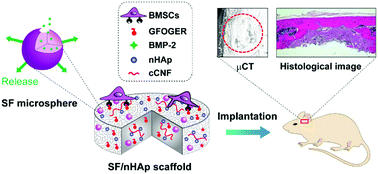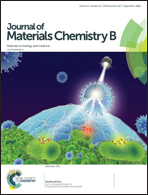Controlled release of BMP-2 from a collagen-mimetic peptide-modified silk fibroin–nanohydroxyapatite scaffold for bone regeneration
Abstract
Stimulating the adhesion and osteogenic differentiation of bone marrow mesenchymal stem cells (BMSCs) is crucial for the scaffold materials used in bone tissue engineering. In this study, a silk fibroin (SF)/nano-hydroxyapatite (nHAp) scaffold was prepared, embedded with SF microspheres containing bone morphogenetic protein-2 (BMP-2) and surface-modified through chemical conjugation with the type I collagen-mimetic peptide GFOGER. Surface-bound GFOGER and sustained BMP-2 release promoted the adhesion and osteogenic differentiation, respectively, of BMSCs. Our results indicated that this system released low doses of BMP-2 in a sustained manner, thereby avoiding cost and safety problems. The biological responses to this scaffold were investigated both in vitro and in vivo. Our results indicated that the synergistic effect of GFOGER and BMP-2 promoted the adhesion and osteogenic differentiation of BMSCs, thus leading to complete bone bridging of rat cranial defects after 12 weeks of implantation. This system might provide a powerful platform for treating bone defects and for bone tissue engineering.



 Please wait while we load your content...
Please wait while we load your content...